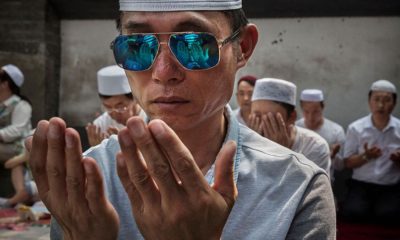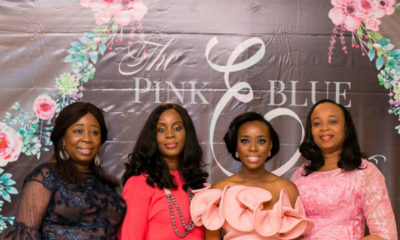Features
Kunmi Omisore: The Veil Debate
 I have this hypothetical friend, Rebecca. I like Rebecca. We’re not entirely different; I mean, we both watch Scandal. We both really enjoy baking and Candy Crush and Olamide’s music. We even have similar life goals. But there’s this one thing about Rebecca… She has this large hairy mole on her face I can’t stop staring it. But, you know, it’s just out of concern for her and all. She should probably have that checked out because it could be cancerous. You never know these things. It’s not because I don’t like moles or they bother me or scare me or anything, it’s really because I care about Rebecca’s welfare. Really.
I have this hypothetical friend, Rebecca. I like Rebecca. We’re not entirely different; I mean, we both watch Scandal. We both really enjoy baking and Candy Crush and Olamide’s music. We even have similar life goals. But there’s this one thing about Rebecca… She has this large hairy mole on her face I can’t stop staring it. But, you know, it’s just out of concern for her and all. She should probably have that checked out because it could be cancerous. You never know these things. It’s not because I don’t like moles or they bother me or scare me or anything, it’s really because I care about Rebecca’s welfare. Really.
As you may be able to tell, I don’t give a crap about Rebecca. Or her ‘welfare’. In actual fact, I am more concerned about the fact that her mole irritates me than about the prospect of it being cancerous and her general well-being.
This is my handy analogy for so-called activists against Muslim women wearing the face veil (hijab). Nearly 100% of those pro-banning the hijab claim to be fighting against oppression and for the equal rights of women across religious and ethnic barriers (mostly living in developed countries). But is that the whole truth? Is that even the truth at all? Allison Pearson, a Telegraph UK writer, says in a 2013 article, “How free is an 11-year-old who only sees her city through a letterbox slit, and who is obliged to dress in a way that intimidates people, prevents any connection being made, and ends up stoking even more racist feeling? How free are the children at the Ayesha Siddiqa Girls’ School, which, like other private Islamic schools, requires pupils to wear a burka or jilbab (headscarf)? The Ayesha Siddiqa School had an emergency inspection earlier this year that raised concerns about the 120 girls’ “welfare, health and safety”.”
How convenient that the welfare, health and safety issues for “those poor girls” – as she describes them in her article – are conveniently addressed after she singlehandedly declares the Muslim headscarf as ‘intimidating’. Her immediate concerns are the prevention of “any connection being made” – which of course has nothing to do with the ‘connectees’ – and the headscarf encouraging racism. She automatically assumes that the young girl or woman under that burka is oppressed and in bondage because it’s a lifestyle that she clearly could never understand, let alone embrace.
The issue is not whether or not the burka, hijab or jilbab is a tool of oppression or not, as that is a massively complex debate in itself. Contrary to popular belief, a significant proportion of Muslim women make the choice to wear a face veil or be fully covered, and believe it to be a symbol of pride in their religion. The issue here is the denial; the denial that a Muslim woman covered simply makes people uncomfortable.
Rhadika Sanghani, a British Indian reporter carried out a real-life experiment. She wore a niqab for a day and reported the dramatic change in people’s reactions and behaviour towards her as a perceived Muslim woman. “People looked at me – and then immediately turned away. There were no shared smiles of consolation when I dropped my iPhone, or sympathetic glances when a teenager playing blaring music sat next to me. With my face covered, nobody knew if I was smiling or frowning. They all assumed I wanted to be left totally alone, without the usual public interactions you can expect on public transport. I didn’t.”
Underlining this debate isn’t mere care and concern for the effects on the Muslim woman or her right to make choices or what she wants/needs. It’s largely a selfish, one-sided argument. It’s about how it makes ‘us’ feel as on-lookers and ‘our’ need to impose certain ideals, not just about how this could or could not be “anti-democratic”.
Some would argue that this is a way of cowering, under the pretense of giving women – of all religions, ethnicities, social class, etc. – “choice” and “freedom of expression”, so as to sweep the important issues under the carpet, but it is not as simple as that. It’s about acknowledging that it appears to affect ‘us’ just as much as ‘we’ believe it affects Muslim women. The Non-Muslim has suddenly become a part of the equation; a ‘consideration’ in the matter. So let’s not pretend it’s all about ‘The Oppressed’. The title of Pearson’s article, ‘The burka casts a veil on all of us – so ban them’, says it all; it’s not just – if at all – about ‘them’, it’s also very much about ‘us’ – whoever that is.
Photo Credit: Dreamstime | R. Gino Santa Maria / Shutterfree, Llc
























